Nobody’s Perfect, but Some are Closer Than Others, Filmmaking-wise
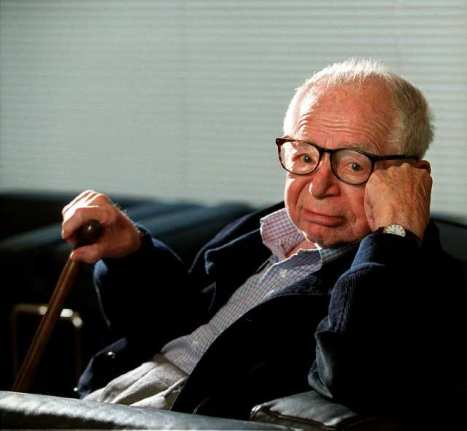 In the early 2000s I was producing a radio show that had Richard Dreyfuss on as a guest. As I answered the phone and prepared to put him on hold for the broadcast, I couldn’t help but ask him a question. The exchange went something like this:
In the early 2000s I was producing a radio show that had Richard Dreyfuss on as a guest. As I answered the phone and prepared to put him on hold for the broadcast, I couldn’t help but ask him a question. The exchange went something like this:
MF: “Mr. Dreyfuss, you’ll be on the air with our hosts soon, but I have to ask you one question: what movie should I watch tonight?”
RD: (Without missing a beat) “Citizen Kane.”
MF: “That’s a great choice Sir, I’ve seen that many times. I’m trying to find something I haven’t seen, and I thought you might have a good suggestion.”
RD: “Let me think……okay. The Apartment, by Billy Wilder.”
MF: “Fantastic! I’ll watch it tonight, thank you so much, Sir!”
I placed him on hold, and my memory is the interview went well, although I do not remember what he was promoting. While I greatly enjoy Billy Wilder’s films, especially Some Like it Hot, Double Indemnity, and Sunset Boulevard, for whatever reason I never ended up watching The Apartment. Because of this, from the time my radio show Max on Movies started in 2006 until the present day, every single “Show Sheet” (a line up of what is on the show that day, e.g. interviews and reviews) has had the following notation: “I have yet to take Richard Dreyfuss’ advice.”
When Zekefilm asked me to contribute to their Film Admissions piece on Billy Wilder, I happily agreed. So of course we kick off this collection of writers talking about their first viewings of Billy Wilder classics with The Apartment, written by……Taylor Blake.
You see, I have yet to take Richard Dreyfuss’ advice.
– Max Foizey
The Apartment
1960, The Mirisch Corporation, dir. Billy Wilder
by Taylor Blake
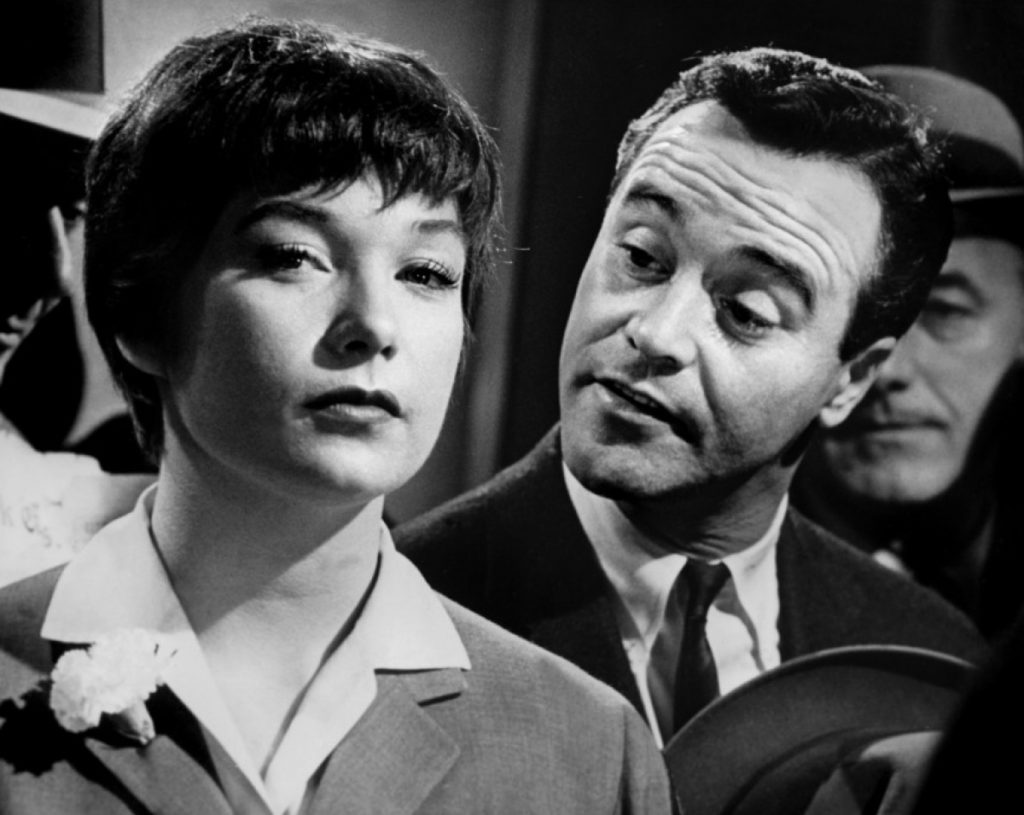
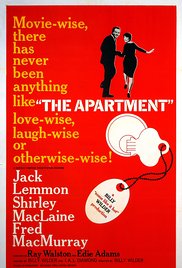 I get a kick out of the original posters for The Apartment: “Movie-wise, there has never been anything like ‘The Apartment,’ love-wise, laugh-wise, or other-wise!”
I get a kick out of the original posters for The Apartment: “Movie-wise, there has never been anything like ‘The Apartment,’ love-wise, laugh-wise, or other-wise!”
While that sounds like typical marketing hyperbole, the Academy seemed to agree: The Apartment was nominated for ten awards and won five, including top dogs Best Original Screenplay, Best Director, and Best Picture.
Would the today’s Academy be so enamored with Billy Wilder’s writing/directing/producing gig? I don’t think so, but that says more about the their current tastes than about him. Voters now like their films historical (12 Years a Slave, Argo, The King’s Speech), experimental (Moonlight, Birdman, The Artist), or issues-focused (Spotlight, The Hurt Locker, Slumdog Millionaire), and they like them most when they can combine those elements. A straightforward, contemporary character drama about a 9-to-5 office job wouldn’t rank high their Oscar bait checklist; so much so, the only Best Picture nominee in the last ten years with any resemblance is Silver Linings Playbook.
But Wilder got a kick out of those straightforward character dramas, and he found his mojo when he was writing “just” a man and a woman talking. He found it in Sabrina and Sunset Boulevard, but his mojo arguably worked its magic best in The Apartment. (No matter how you rank those three, we can agree they all beat Love in the Afternoon.) Jack Lemmon and Shirley MacLaine bring fully realized people to a New York City apartment, he an insecure conformist, she a wounded spark. They’re both dreamers of the same sort, ones who yearn for the stability that comes with unconditional acceptance.
For something so simple, it digs deeper and darker than you’d think if you’ve only seen the image of Lemmon and MacClaine’s playful hand of gin rummy. Yes, it’s witty (“When you’re in love with a married man, you shouldn’t wear mascara.”), but it’s just as heartbreaking. (In the age of #MeToo, it weighs even heavier.) Today’s Hollywood may not be so enamored with these stories, but it would probably be better for them.
Irma la Douce
1963, The Mirisch Corporation, dir. Billy Wilder
by Lydia Hardy
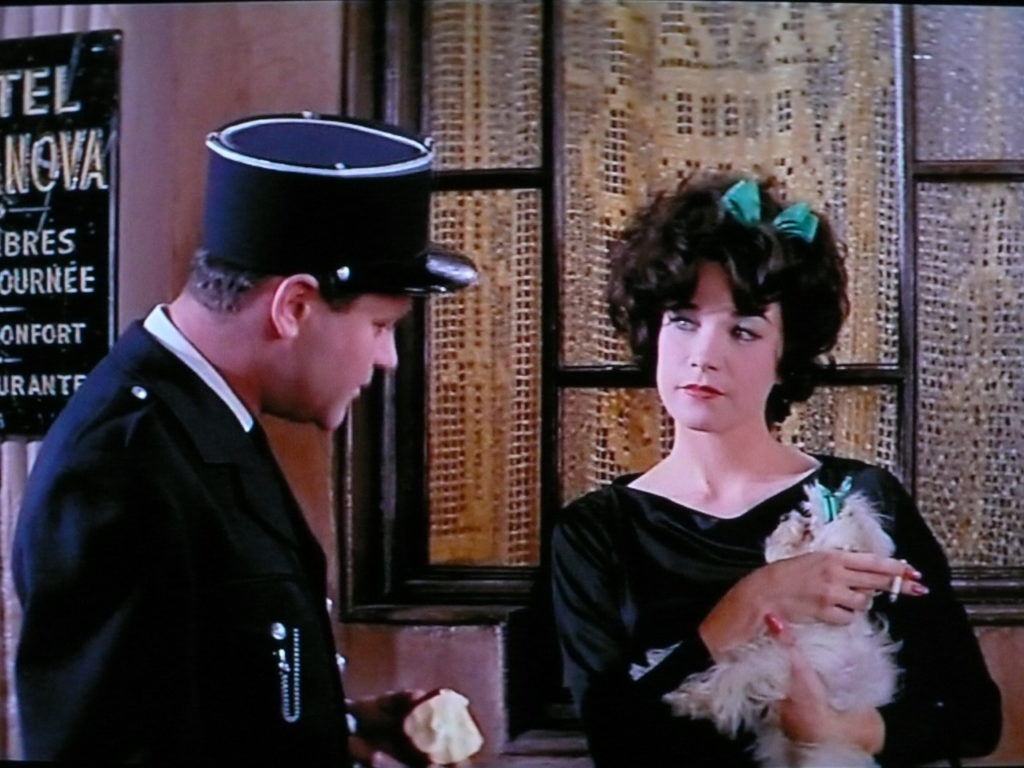
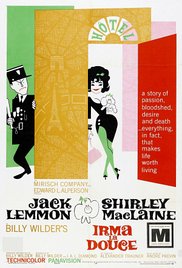 Billy Wilder’s 1963 classic Irma la Douce is a sweet and delightfully screwy, nostalgic romp. Jack Lemmon plays Nestor Patou, a young, naïve policeman who is adorkably scandalized by green underwear and surprised to find prostitutes in the red-light district. It doesn’t take Nestor long to find the green-stockinged title character, but he is reluctant to believe she is a prostitute because well, he likes her.
Billy Wilder’s 1963 classic Irma la Douce is a sweet and delightfully screwy, nostalgic romp. Jack Lemmon plays Nestor Patou, a young, naïve policeman who is adorkably scandalized by green underwear and surprised to find prostitutes in the red-light district. It doesn’t take Nestor long to find the green-stockinged title character, but he is reluctant to believe she is a prostitute because well, he likes her.
He visits the local café where the bartender, who is also our narrator gives a rather persuasive argument on the economic benefits of prostitution. After which, Nestor decides to raid the hotel where he saw Irma enter. He is fired soon after for interfering with the status quo (the Chief happened to be one of the Johns) He finds himself back in the café with Irma, who does not recognize him at first. When her pimp accosts her, and sends her back out into the rain to work, Nestor leaps to her aid, and in an unlikely outcome to a side-splitting brawl he beats him. The next morning Irma insists that Patou become her new pimp even though he wants her to quit her job.
After a lengthy discussion with the bartender/narrator Moustache, Nestor decides to create a wealthy alter-ego to support Irma so that she’ll only have to be with him. “Lord X” visits Irma twice a week for the price of five-hundred francs, and Nestor must work hard to obtain the money all the while keeping it a secret. When Irma starts to miss Nestor, she begins to fall for Lord X.
Irma tells Nestor that she is going to run away with Lord X and filled with a jealous rage Patou decides the only solution is to murder his alter-ego, which he accomplishes by throwing his costume into the Seine. However, everyone believes that he has actually committed murder and he is sent to a charming French prison where the inmates march in circles and the bars are made of rubber. He manages a ridiculous escape from this place when he finds that Irma is pregnant. He escapes from the police with another screwball shenanigan and he and Irma live happily ever after.
It’s not the sort of film that would hold up to too much scrutiny. But it’s witty and colorful and most of all it’s funny. Billy Wilder was a gifted director of every genre he touched but his screwball comedies shine the brightest. This movie doesn’t attempt to give us real humanity it’s a farce and where so many farces fall flat or uncanny this one doesn’t, in large part thanks to the irrepressible performances of Jack Lemmon and Shirley MacLaine. Irma’s spunky, sassy charisma and Patou’s neurosis-fueled shenanigans are the perfect vehicle for a match made in comedy heaven.
The Fortune Cookie
1966, The Mirisch Corporation, dir. Billy Wilder
by Sharon Autenrieth
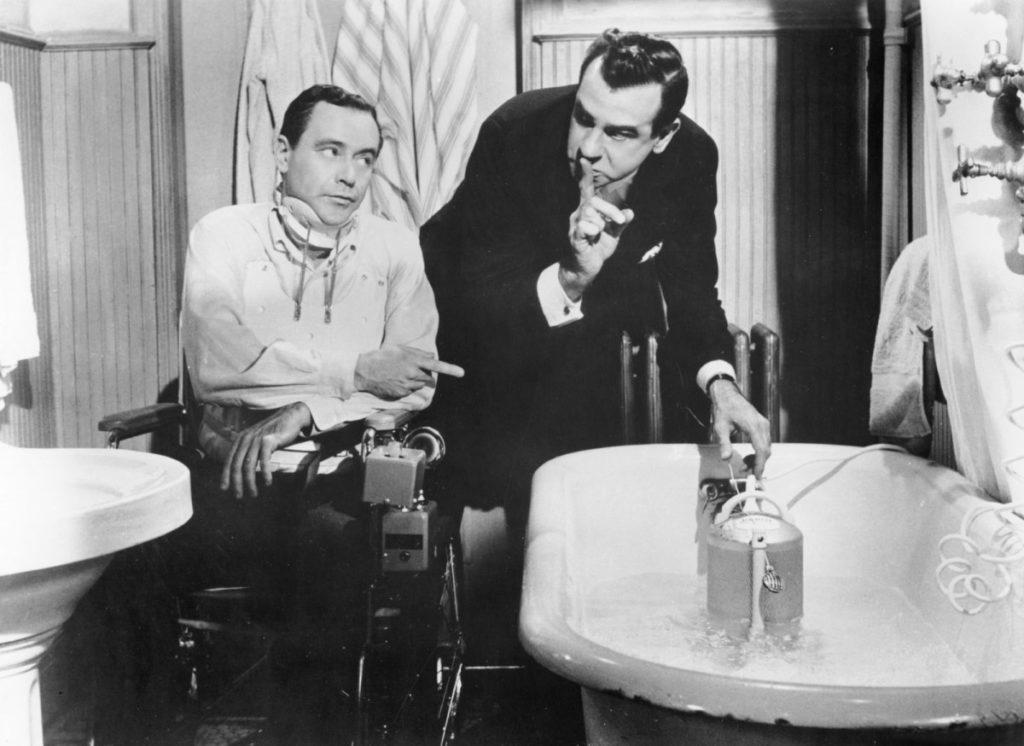
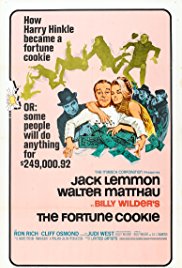 The Fortune Cookie left me a bit cold – perhaps because it is populated entirely by cold hearted schemes – crooked lawyers, gold diggers, greedy family members. Billy Wilder’s 1966 film of a thoroughly amoral ambulance chaser trying to cash in his brother-in-law’s very minor injury has the kind of cynicism that comes from a moralist. Billy Wilder believes we should be better, but we’re not: so he holds up a smartly crafted, very funny mirror and what reflects back is hard to stomach.
The Fortune Cookie left me a bit cold – perhaps because it is populated entirely by cold hearted schemes – crooked lawyers, gold diggers, greedy family members. Billy Wilder’s 1966 film of a thoroughly amoral ambulance chaser trying to cash in his brother-in-law’s very minor injury has the kind of cynicism that comes from a moralist. Billy Wilder believes we should be better, but we’re not: so he holds up a smartly crafted, very funny mirror and what reflects back is hard to stomach.
Harry Hinkle (Jack Lemmon) is an inoffensive but weak willed sports photographer who is in the wrong place at at the wrong sideline during a Brown’s game. Knocked unconscious by a collision with Brown’s rising star Luther “Boom Boom” Washington (Ron Rich), Hinkle is taken to the hospital where his brother-in-law Willy Gingrich (Walter Matthau) sees Hinkle’s long-healed childhood spinal injury as a chance to dip into the deep pockets of the NFL. Hinkle resists, but not for long. He has the flimsy convictions born of being a nice man, but not necessarily a good one. He’s also still pining for his wife, an opportunistic blonde who left him for a singing career and greener pastures. We see the “greener pastures” sleeping in her bed and showering in her bathroom – The Fortune Cookie is pretty direct with the sexual content.
Once Hinkle has agreed to the scheme the rest of the film is a battle of wits between lawyers and doctors representing the NFL (and an obsessive private detective played by Cliff Osmond) and Gingrich. Will may be seedy and operate out of a disheveled office with a broken rolltop desk, but he’s plenty smart, knows how to work and angle, and has no scruples to get in the way. Harry hates being confined to a back brace and wheelchair, but it seem worth it when his wife, Sandy (Judi West) shows up talking reconciliation. Of course, she’s seeing dollars signs and has no real interest in Harry himself.
There is, in fact, only one decent person in The Fortune Cookie: Luther “Boom Boom” Washington. Boom Boom is horrified with the idea that he might have seriously injured Hinkle, and becomes his devoted caretaker. He starts skipping team practices, is “off” in games, and even takes up the drinking that he says derailed his father’s life. His collision with Harry threatens to destroy Boom Boom’s future entirely. He seems so naive and imprudent in his response to the accident, that Wilder seems to suggest that to be a kind and selfless person requires being a bit of a sucker; clueless; maybe even a little dumb.
Ron Rich didn’t have much of an acting career after The Fortune Cookie, but he gives a very natural, likeable performance here. Lemmon is as exasperated as ever, but Matthau steals most of their scenes – and the rest of the movie. He’s a terrific down-in-the-heel villain, always and only out for himself.
Still, as I said, I didn’t love The Fortune Cookie. Maybe Wilder’s grim depiction of human nature is accurate, but it’s still hard to accept with laughter.
Some Like It Hot
1959, Metro-Goldwyn-Mayer, dir. Billy Wilder
by Krystal Lyon
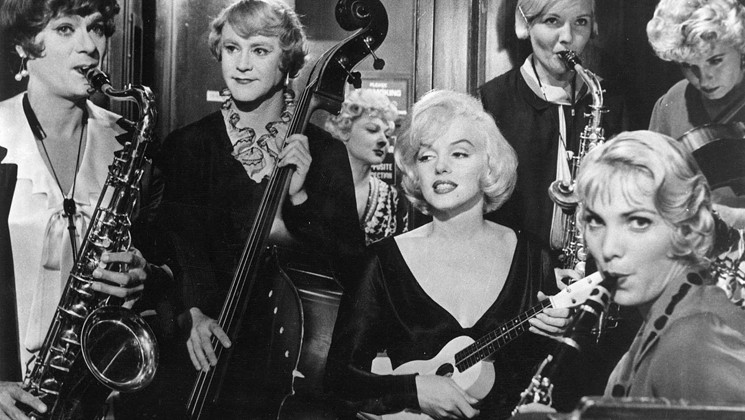
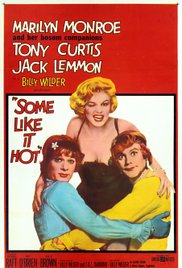 When I was an angsty teen I had three black and white posters above my bed. James Dean from Rebel Without A Cause, a basic Charlie Chaplin poster and a ukulele toting Marilyn Monroe from Some Like It Hot. I was too hip for the grunge movement that I’m obsessed with now! To be honest I hadn’t seen any James Dean, Charlie Chaplin or Marilyn Monroe films, I just thought they were the coolest and faked the rest. This is a Film Admission piece, right? Since those drama filled teen days I’ve soaked up some Chaplin and I’ve seen a few Dean and Monroe pictures too, but Some Like It Hot had slipped through the cracks… until now. (PS… It’s on Amazon Prime, so go watch it pronto.) Some Like It Hot’s trailer from 1959 proclaimed, “Not since Scarface, so much action! Not since the Marx Brothers, so much comedy! And not since The Seven Year Itch, so much Marilyn!” Thrills, comedy and Marilyn, what more could I want?
When I was an angsty teen I had three black and white posters above my bed. James Dean from Rebel Without A Cause, a basic Charlie Chaplin poster and a ukulele toting Marilyn Monroe from Some Like It Hot. I was too hip for the grunge movement that I’m obsessed with now! To be honest I hadn’t seen any James Dean, Charlie Chaplin or Marilyn Monroe films, I just thought they were the coolest and faked the rest. This is a Film Admission piece, right? Since those drama filled teen days I’ve soaked up some Chaplin and I’ve seen a few Dean and Monroe pictures too, but Some Like It Hot had slipped through the cracks… until now. (PS… It’s on Amazon Prime, so go watch it pronto.) Some Like It Hot’s trailer from 1959 proclaimed, “Not since Scarface, so much action! Not since the Marx Brothers, so much comedy! And not since The Seven Year Itch, so much Marilyn!” Thrills, comedy and Marilyn, what more could I want?
The plot is simple. Two down-on-their-luck musicians Joe, Tony Curtis and Jerry, Jack Lemmon, accidentally witness a mob hit and are on the run from Spats Colombo and the rest of his cronies. In order to get out of Chicago they disguise themselves as ladies and join an all-female band headed to Florida. The bubbly and buxom Sugar Kane, Marilyn Monroe, is also in the band and she becomes instant friends with Daphne, aka Jerry and Josephine, aka Joe. Everything is working out swell and Joe even figures out a way to woo Sugar by impersonating a rich oil tycoon, but then the Chicago mob shows up, and the fireworks really start! This Billy Wilder comedy might seem tame by today’s standards, how many times have we seen men pretending to be ladies in order to attain something? (The Birdcage, Jack And Jill, Mrs. Doubtfire, White Chicks to name a few.) But in 1959 Some Like It Hot stretched the boundaries in more ways than one.
The posters came with a warning, “NOT SUITABLE FOR CHILDREN”! Was it the constant tongue in cheek banter between Sugar and Daphne, the cross dressing men being pursued by other men or the fact that Monroe looked topless for half of the film? All three pushed the limits of what was deemed acceptable and Some Like It Hot was condemned by the Legion of Decency and it was banned in the entire state of Kansas. Labeled as “morally objectionable” and censored in multiple locations, I wonder if Wilder even cared. On the original poster Curtis and Lemmon were named Monroe’s “Bosom Companions” which kinda feels like a middle finger to the censors. Wilder loved the story, he’s a co-writer along with I.A.L. Diamond, he loved/hated working with Marilyn and he knew America would eat it up! Today Some Like It Hot is considered the “Quintessential American Comedy” and it’s number 14 on AFI’s list of Top 100 Films of all time. So take that, Legion of Decency!
This fast paced comedy is a kick, and Monroe, Curtis and Lemmon are all in top form! So, cheers to Wilder and crew, for pushing the boundaries, taking chances and making us all laugh at our imperfections. After all “Nobody’s Perfect”!
The Seven Year Itch
1955, Twentieth Century Fox, dir. Billy Wilder
by Jeffery Knight
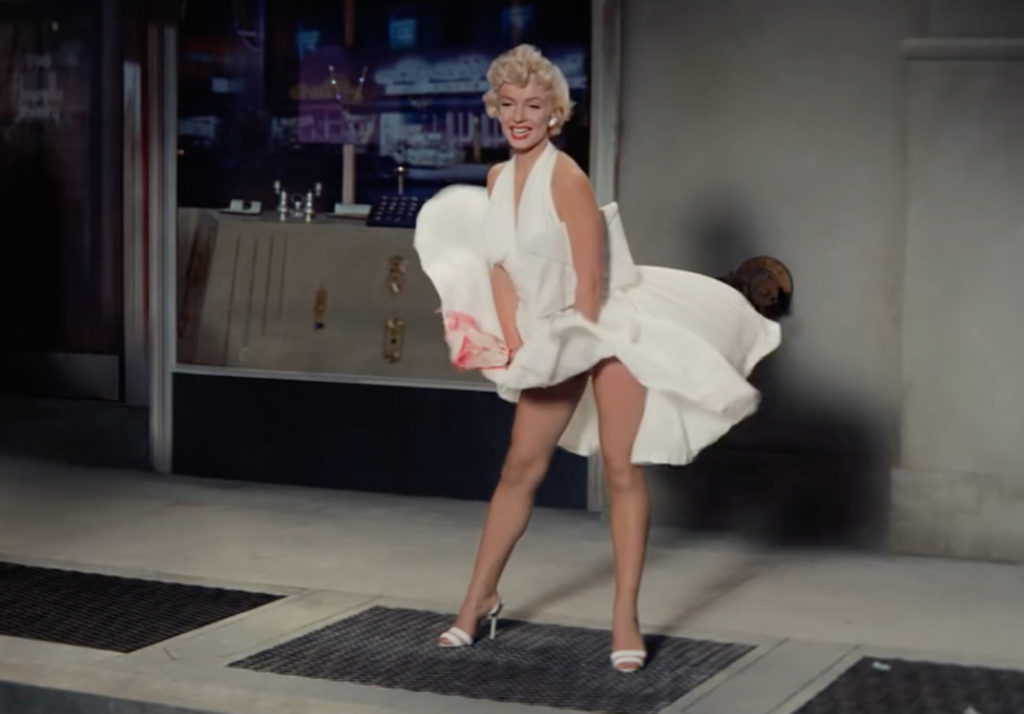
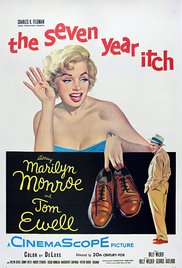 George Axelrod’s stage play, The Seven Year Itch, was a smash hit on Broadway. Hollywood Studios, naturally, wanted a piece of the action by adapting the play to film. The problem was that the play contained subject matter that was too hot for Hollywood to handle, given the production code that was still firmly in place during the early to mid-fifties. When he selected the play as his next project, Wilder had to have known he was stepping into a hornet’s nest of pearl clutching moralists. But maybe he figured that if anyone could get a film made of Axelrod’s play, he could.
George Axelrod’s stage play, The Seven Year Itch, was a smash hit on Broadway. Hollywood Studios, naturally, wanted a piece of the action by adapting the play to film. The problem was that the play contained subject matter that was too hot for Hollywood to handle, given the production code that was still firmly in place during the early to mid-fifties. When he selected the play as his next project, Wilder had to have known he was stepping into a hornet’s nest of pearl clutching moralists. But maybe he figured that if anyone could get a film made of Axelrod’s play, he could.
The film turned out to be a huge hit (it was one of the ten top-grossing films of 1955), but sacrifices had to be made. While the script, which Wilder co-wrote with Axelrod, followed the broad outlines of the original play, elements of the stage production had to be rewritten, toned-down or left out completely. The Production Code in place at the time did not allow the act of marital infidelity to be played for laughs- which was the entire point of the story. Both Wilder and Axelrod felt straightjacketed by the restrictions placed on them. Nevertheless they were able to turn out a sharply written farce that, for all its compromises, would deliver one of the most iconic performances in motion picture history.
Make no mistake, Billy Wilder is a master screenwriter and nobody directs his scripts better than he does himself, but The Seven Year Itch is not his movie. It belongs wholly to Marilyn Monroe, who plays the unnamed upstairs neighbor to the nebbish Richard Sherman (Tom Ewell). Hollywood censors saw to it that the script excised any prurient and racy material from the play, but Monroe exudes such raw sensuality that you forget that the most overt sex act in the film is a brief and clumsy kiss that ends in a pratfall. Wilder knew what he had in Monroe- which is why he was willing to put up with her erratic and self-destructive behavior on set even though it was causing the film to go over budget. Whatever the Production Code made Wilder the writer take out, Wilder the director was able to use Monroe’s performance to put it back in.
The Seven Year Itch isn’t Wilder’s sharpest or most incisive film. It’s not as bitter or as cynical as Sunset Boulevard or Ace in the Hole. It’s an amusing little sex farce that doesn’t feature any sex. Nonetheless, the film earns its place in the canon because of Marilyn Monroe. There’s a reason the image of her with her dress billowing up from the subway updraft still remains the summit of movie-star sex appeal.
Sunset Boulevard
1950, Paramount Pictures, dir. Billy Wilder
by Erik Yates
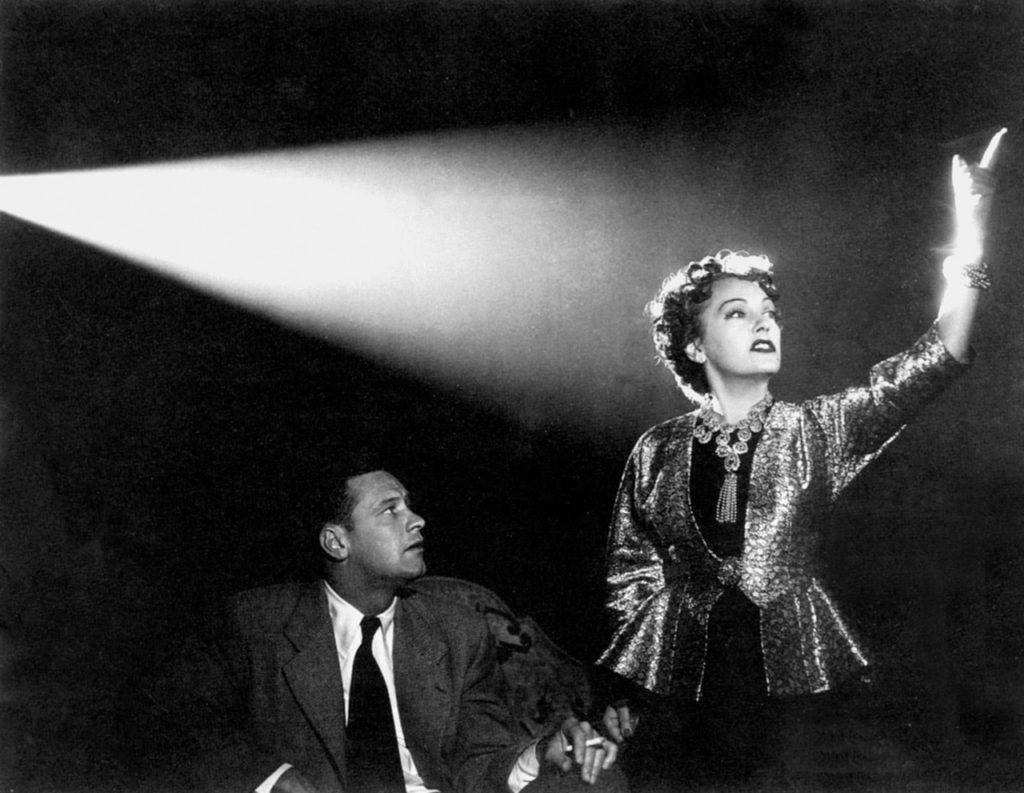
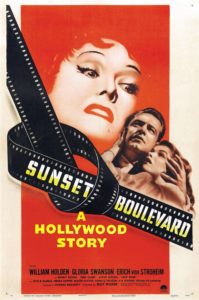 I’ve heard many of the lines, “All right, Mr. DeMille, I’m ready for my close-up.”, “Audiences don’t know somebody sits down and writes a picture; they think the actors make it up as they go along.”, or “I am big! It’s the pictures that got small!”. Despite knowing the references, Sunset Boulevard is a film, along with too many other Billy Wilder films, that represents glaring hole in my film repertoire.
I’ve heard many of the lines, “All right, Mr. DeMille, I’m ready for my close-up.”, “Audiences don’t know somebody sits down and writes a picture; they think the actors make it up as they go along.”, or “I am big! It’s the pictures that got small!”. Despite knowing the references, Sunset Boulevard is a film, along with too many other Billy Wilder films, that represents glaring hole in my film repertoire.
In fact, if each Billy Wilder film I hadn’t seen before was a bullet, my body would resemble one of songwriter Bill Mallonee’s “bullet riddled fuselages”. Now, after admitting to this, I am happy to say that I’ve finally rectified one of his biggest films. Sunset Boulevard has lots of elements that have been pillaged so many times over the years that they are caricature now. The voice-over narration speaking like a detective in a Film Noir describing everything he comes across as, “it was the kinda (thing) that (insert analogy)”, or “it had (this) and it had it in spades” which is actually said here about the house of Norma Desmond (Gloria Swanson), the formerly big celebrity silent film star who now holes herself up in her mansion lamenting when films began to talk, while secretly plotting a script to bring her back to prominence.
The film also starts at the end, and then uses the duration of the film to catch us up on how it got to that point where we were introduced to the protagonist, Joe Gillis, played by William Holden. What you have to remember is that when Sunset Boulevard came out, it wasn’t necessarily pillaging and perpetuating a film device, as much as elevating it. It’s only sixty-seven years later that we can discuss it being a caricature. The film is a dream film for writers as they take central stage in the industry they fuel yet so often reap so little of the rewards. Cameos by Cecil B. DeMille and Buster Keaton only add to the insider feel Sunset Boulevard brings of the golden age of Hollywood. By the end, we are enthralled with the story and the characters, all being delivered by the strong cast which also includes Erich von Stroheim and Nancy Olson. It’s a classic for a reason; worth the watch, even if some of its storytelling devices have become wearisome all of these years later.
Stalag 17
1953, Paramount Pictures, dir. Billy Wilder
by Jim Tudor
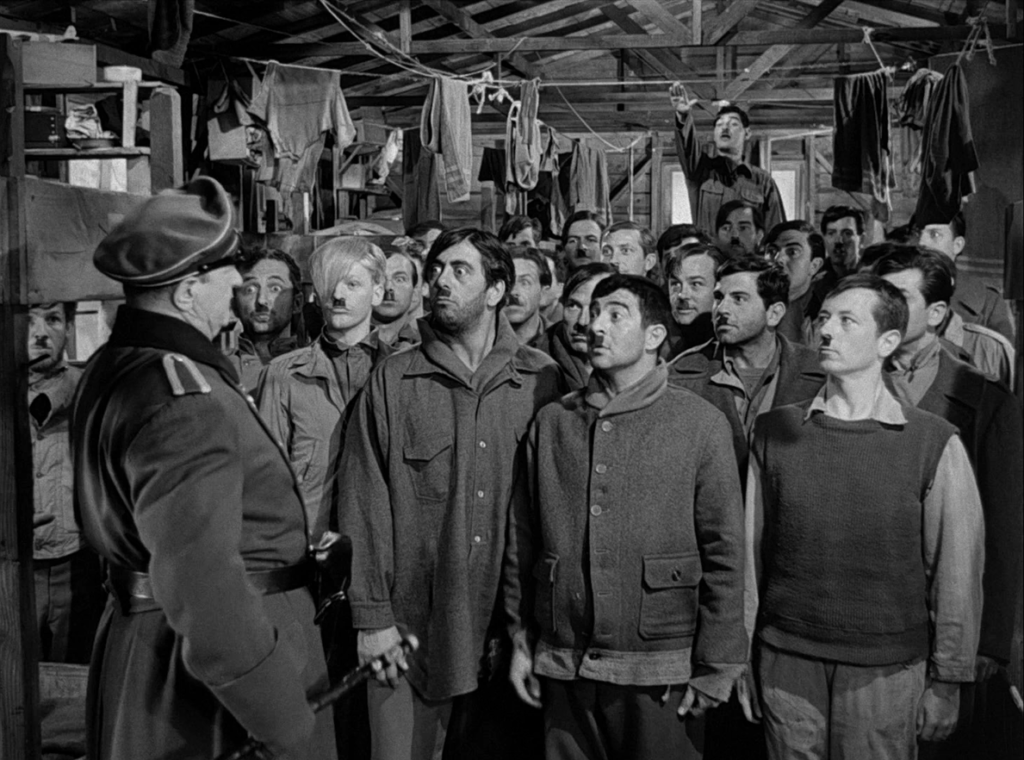
 Unlikely movie magic spurned by screenwriting perfection, the genre-mixing World War II P.O.W. camp comedy once again finds Billy Wilder in the mud. This following the cynically honest Ace in the Hole, which spent significant time in a collapsed mine. Dare I say, the mud in Stalag 17 is even more prominent. Much is made of Otto Preminger’s entrance to the yard for his address to the prisoners, as his own underlings must lay down plank after plank just for him, over the soft mud. Preminger’s character, Oberst von Scherbach, is ever the perfectly tailored dictator of his own corner of world at war. Wilder, no slouch himself in the clothing department, made a point of not being so persnickety about the mud. He’s said to have directed Stalag 17 intentionally in his nicest shoes, his way of demonstrating his solidarity to the crew and the subject matter. For a director who’s evidence of mastery of nearly every type of film stops abruptly before “Western” (he couldn’t abide horses, if I recall correctly), this is a big deal.
Unlikely movie magic spurned by screenwriting perfection, the genre-mixing World War II P.O.W. camp comedy once again finds Billy Wilder in the mud. This following the cynically honest Ace in the Hole, which spent significant time in a collapsed mine. Dare I say, the mud in Stalag 17 is even more prominent. Much is made of Otto Preminger’s entrance to the yard for his address to the prisoners, as his own underlings must lay down plank after plank just for him, over the soft mud. Preminger’s character, Oberst von Scherbach, is ever the perfectly tailored dictator of his own corner of world at war. Wilder, no slouch himself in the clothing department, made a point of not being so persnickety about the mud. He’s said to have directed Stalag 17 intentionally in his nicest shoes, his way of demonstrating his solidarity to the crew and the subject matter. For a director who’s evidence of mastery of nearly every type of film stops abruptly before “Western” (he couldn’t abide horses, if I recall correctly), this is a big deal.
A bigger deal: According to Captain Dale Dye, the professional military consultant who’s interviewed on the DVD bonus features, 93,000 Americans had been captured by Germans in WWII. Obviously, this was no laughing matter, particularly in then-contemporary Korean War times. Yet, Stalag 17’s source material, other than the actual Stalag 17b which was indeed a real thing in WWII, was a hit play written by Donald Bevan and Edmund Trzcinski. Even though it all starts with two American G.I.s getting machine gunned to death during an attempted escape, the camaraderie between the rest of the guys in the barracks in question is downright raucous and infectious.
Pilots were of particular interest to the enemy, since they thought the airmen were probably privy to more inside intel. Hence, the added threat to barracks newcomer Lt. Dunbar, a heroic pilot played by Don Taylor. Escape remains a priority, despite the regular shenanigans of the group. Wilder presents this aspect with a perfect balance of comedy and pathos of watching grown men mentally crack up. Harvey Lembeck and Robert Strauss, playing the mischief makers Shapiro and Betty Grable-obsessed “Animal”, steal every moment they’re given. Their kooky, whacked chemistry is resonant, rare, and essential.
But Dunbar must be saved. The problem: there’s a spy in their midsts. Who is it? Everyone looks no further than Sefton, a cynical loner with a suspicious knack for free enterprise, even when it comes to making deals with the enemy. Though William Holden, the film’s star, imbues the character with pitch perfect presence, it’s said he didn’t at all care for the role. The joke was on him; Holden won Best Actor at the Academy Awards for his part. Likewise, sort of, Wilder supposedly chucked his own Best Director statuette for his work on Stalag 17 into a wall backstage during the ceremony. It should’ve been for Sunset Boulevard, he thought.
Being one of Hollywood’s greatest wits and most prominent filmmaking talents, Wilder knew how good he was. Having grown up a Viennese refuge, there was never any danger of his adaptation of Stalag 17 falling off into complete irreverence at the expense of the situation. Many years later, in the Book Conversations with Wilder, the filmmaker discussed with writer and fellow filmmaker Cameron Crowe that he wanted Schindler’s List to be his final film, but let it go to Spielberg. That, no doubt, would’ve been something altogether different from Stalag 17, but nevertheless courting inevitable comparison. In any case, with his ability and tenacity to blend genres and unlikely sensibilities, Billy Wilder was many things, but stuck in the mud was never one of them.
As for Stalag 17, it’s own near- perfection (fact: “Nobody’s perfect!” extends to movies themselves) makes it a highly satisfying better-late-than-never first time film discovery. It may just be the best prison camp escape movie ever made.
Fedora
1978, Lorimar, dir. Billy Wilder
by Robert Hornak
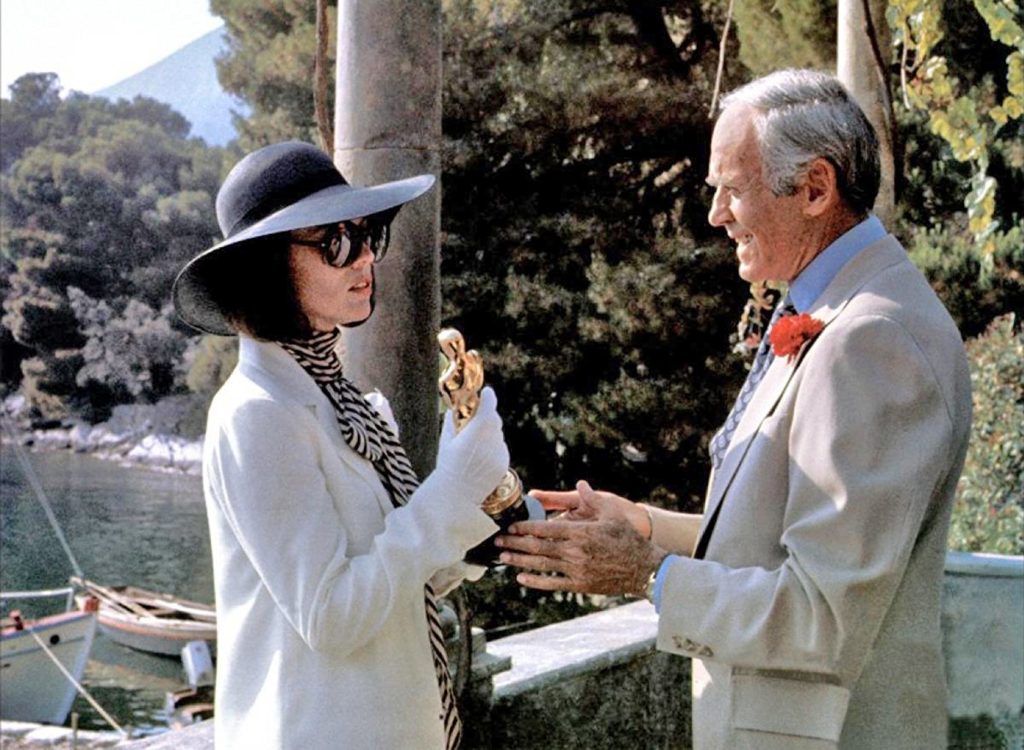
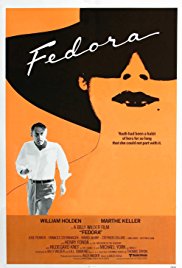 This is Wilder’s second-to-last film, made at the still-feisty age of 72. I’d already recently watched his most-previous work, an updated The Front Page (1974), that took the original play and 1931 film version (itself updated into Howard Hawks’ perfect 1940 classic His Girl Friday) and for some reason decided to slow it down, somehow hoping added scenes and profanity would hold it aloft. It doesn’t; it’s remarkably charmless. So the old man’s age was showing, making it especially relieving to watch him here, in Fedora, handily push through what is essentially a noir construct (feature-length flashback, hero knocked out halfway through, femme fatales) with the modern look of the late ’70s. The man had basically sealed the deal on film noir with 1944’s Double Indemnity and yanked comedy into neurotic adulthood with The Apartment (1960), so he had the longstanding clout and wherewithal to make a late-in-life mix of the two – notably borrowing the comedy-drifting-into-drama structure of The Apartment to sucker us into some third act pathos.
This is Wilder’s second-to-last film, made at the still-feisty age of 72. I’d already recently watched his most-previous work, an updated The Front Page (1974), that took the original play and 1931 film version (itself updated into Howard Hawks’ perfect 1940 classic His Girl Friday) and for some reason decided to slow it down, somehow hoping added scenes and profanity would hold it aloft. It doesn’t; it’s remarkably charmless. So the old man’s age was showing, making it especially relieving to watch him here, in Fedora, handily push through what is essentially a noir construct (feature-length flashback, hero knocked out halfway through, femme fatales) with the modern look of the late ’70s. The man had basically sealed the deal on film noir with 1944’s Double Indemnity and yanked comedy into neurotic adulthood with The Apartment (1960), so he had the longstanding clout and wherewithal to make a late-in-life mix of the two – notably borrowing the comedy-drifting-into-drama structure of The Apartment to sucker us into some third act pathos.
Much of Fedora‘s music is pointedly “old”-style orchestration, and it’s hard to tell at first if Wilder is commenting on the material with an ironic touch or simply stuck in a mode he can’t wrestle out of. But as it moves along, it’s clear the movie’s aware of itself, in that ironic way, as William Holden’s sardonic presence and smoker’s voiceover shifts the gears of the plot into a kind of spiritual sequel/reimagining of Sunset Boulevard (1950) as surely as if he were pressing the get-away clutch on Norma Desmond’s old Usitta-Fraschini. The fun of the movie is its knowing nods to that earlier classic, but flipped slightly: titular Fedora is a still-beloved actress constantly of late in the incognito mode, trying to avoid anyone and everyone, especially nosecats like Holden, an independent film producer and screenwriter, on the make to put her in a movie he’s written called “The Snows of Yesteryear” – a Wilder-worthy faux title that loves the perfect pitch of its own fauxness. Holden uses an ancient memory of their one night on the Santa Monica beach as leverage, willfully pushing into Fedora’s life until he discovers something deeper and murkier there beyond the basic premise.
There’s some slippage into the maudlin a bit too often for my taste, especially for what is at first obviously a comedy, but it’s forgivable as the direct imprint of a filmmaker used to doing whatever he wants. The biggest issue here is its satire, always apparent, but not as fanged as much of the catalogue behind it, maybe mostly thanks to the lack of a truly hard Hollywood target: this film’s quote “It’s a whole different business now, the kids with beards have taken over – they don’t need a script, just give’em a camera with a zoom lens” is anemic against the former film’s “I am big! It’s the pictures that got small.” So it never achieves the sharp and morbid satire of Sunset Boulevard, but it still works as a quasi-sophisticated, mutedly-farcical, meta-may-care take on Hollywood glamour, success, and ambition. The greatest takeaway is the circumspect POV of the filmmaker. By the end, Wilder’s alchemy has drawn out the audience’s love, not for Fedora, but for the ephemeral mystique of Fedora – an old man’s earned indictment of the unreal heart of Hollywood, fame, fandom, and any kind of earthly glory, essentially and gleefully wiping the gold plating off his own mantel-ful of Oscars.
Witness for the Prosecution
1957, MGM, dir. Billy Wilder
by Max Foizey
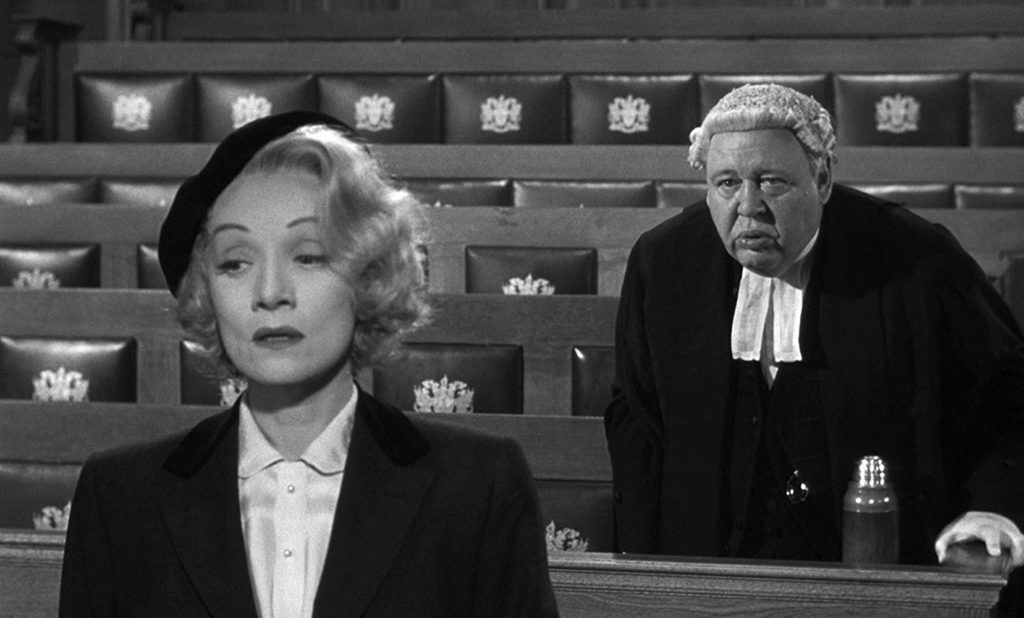
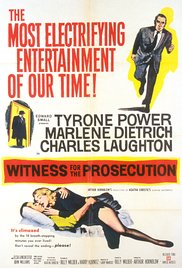 Based on the play of the same name by Agatha Christie and adapted for the screen by Larry Marcus, Harry Kurnitz, and Billy Wilder (who also directed), Witness for the Prosecution stars Charles Laughton in a powerhouse performance as Sir Wilfrid Robarts, a well-respected barrister recovering from a massive heart attack, who is anxious to get back to work.
Based on the play of the same name by Agatha Christie and adapted for the screen by Larry Marcus, Harry Kurnitz, and Billy Wilder (who also directed), Witness for the Prosecution stars Charles Laughton in a powerhouse performance as Sir Wilfrid Robarts, a well-respected barrister recovering from a massive heart attack, who is anxious to get back to work.
Robarts takes a meeting with murder suspect Leonard Vole (Tyrone Power), who explains to Robarts that he quite innocently became friends with an elderly widow named Emily French, who took a liking to him the more time they spent together. When the old woman is murdered, Vole becomes the prime suspect, as he was the last person to see her alive. And because she left him her fortune of 80,000 pounds in her will.
Robarts takes the case against the wishes of his private nurse, Miss Plimsoll (Elsa Lanchester, Laughton’s wife), who worries the stress may be too great for his condition. Robarts believes Vole to be innocent and his belief is cemented once he speaks to Vole’s German wife Christine (Marlene Dietrich), a cold, straightforward woman who provides an alibi for her husband. But when the case goes to trial, Robarts is shocked when Christine is called as a witness not for the defense, but the prosecution.
At the time of the film’s release, the advertising campaign begged audiences not to divulge the ending of the film, and of course I won’t do so here. But it’s easy to draw a line from Witness for the Prosecution to more recent thrillers like Primal Fear and Fracture. Billy Wilder is a master filmmaker and this film highlights his talent for hilarious dialogue and sleek camera work. He’s also an actor’s director, as proven by Marlene Dietrich’s powerful entrance in the film, and the overall work done by the excellent ensemble cast. Everyone is a joy to watch, especially Laughton, Lanchester, and Power, who is extraordinary in every regard in what would be his final film role.
Ben Affleck has expressed interest in directing and starring in an update of this film, and while I’m not sure he could fill Mr. Wilder’s shoes in the director’s chair, I can see how he would be a good fit for Tyrone Power’s role. The bigger question becomes who on earth could rock the role of Christine as well as Marlene Dietrich? Let the speculation begin.
With memorable dialogue (“He’s like a drowning man clutching at a razor blade”) and perhaps the most intimidating use of a monocle in film history, Witness for the Prosecution is an engaging film that lives up to its reputation as a courtroom drama classic.

